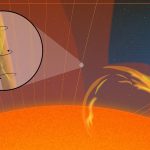How eating dead animals may have helped make us human
A new study suggests that scavenging—the act of eating the meat of dead animals—may have played a much bigger role in human evolution than...
Ancient volcano eruption predates Pharaoh Ahmose, changing Egypt’s ancient timeline
One of the biggest volcanic eruptions in the last 10,000 years shook the Greek island of Thera—today known as Santorini.
The massive explosion sent ash...
Dinosaur “mummies” reveal what these giants really looked like
For the first time, scientists have uncovered a clear and complete picture of what a large dinosaur looked like in real life—thanks to two...
Dinosaurs in New Mexico were thriving until the asteroid hit, study finds
For years, scientists thought dinosaurs were already declining before an asteroid wiped them out 66 million years ago.
But new research from Baylor University, New...
Scientists finally detect hidden solar waves that could power the sun’s mysterious corona
For more than 80 years, scientists have been searching for a special kind of magnetic wave inside the sun that could help explain one...
Hidden in the Sun’s glare, this asteroid is uncomfortably close to Earth
In the distant past, the Solar System was rife with impacts and collisions.
Millions of rocky objects zoomed chaotically through the system, smashing into each...
Scientist have uncovered the first evidence of the 4.5-billion-year-old “Proto Earth”
Earth has a long, 4.5 billion history full of momentous twists and turns.
Multiple prominent events played leading roles in Earth's story.
One of them is...
51-million-year-old fossil reveals ancient origins of non-biting flies
A newly discovered fossil from Australia is rewriting what scientists know about the origins of non-biting midges—tiny insects that thrive near lakes and rivers.
The...
The sixth extinction? How humans are driving species to the edge of survival
Human activity may be setting the stage for the largest extinction event since the asteroid that wiped out the dinosaurs 66 million years ago,...
Earth’s magnetic shield is weakening over the Atlantic, scientists warn
Scientists have discovered that a weak spot in Earth’s magnetic field—known as the South Atlantic Anomaly—is continuing to grow.
Using 11 years of precise data...










